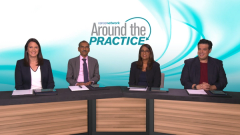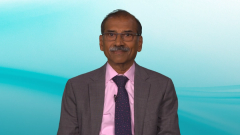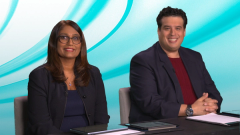
What is the Role of Transplant in Newly Diagnosed Multiple Myeloma?
A brief review of the role of transplant in patients with newly diagnosed multiple myeloma and how it can be best coupled with systemic treatment.
Episodes in this series

Transcript:
Sundar Jagannath, MD:You heard your 2 colleagues, Dr Rossi, talking about quadruple therapy and then we heard about the MASTER trial. You talked about your patient and that you took the patient through transplant. Do we still need to do transplant; do you believe in transplant? What do you think is the future of the transplant?
Shambavi Richard, MD: I think that transplants are still very much a very important tool in newly diagnosed myeloma. I do think that they remain, as of now, still, the cornerstone of treatment until we can prove that other modalities are better or have advantages. We have seen now from both the DETERMINATION and the IFM 2009 [clinical trials] that there is a clear difference for progression-free survival. Now granted we’re not seeing overall survival, the differences, which is the gold standard when we evaluate the benefits of the therapy. But when we think about it, myeloma is a disease where the median overall survival now is close to 10 years. So to really be an overall survival benefit, especially with the excellent research that has been going on in this field and the novel treatments that are really great at salvaging patients when they have relapsed, it’s going to be very difficult to show that overall survival benefit. But I don’t think we should underrate the importance of what a progression-free survival benefit is. I think that’s my first reason why I think this is important. In fact, there are additional trials too, the FORTE, for instance, showed clearly that KRd [carfilzomib (Kyprolis), lenalidomide (Revlimid), and dexamethasone] transplant is superior to 12 cycles of KRd. So again, we’re seeing a difference in terms of progression-free survival, which corroborates the results from the other 2 studies that even with novel therapies that this is still a great benefit. Now, we don’t have the results. We haven’t ever had a study where transplant is now compared to the new quad. And if that’s going to be the standard of care, then we’re going to have to reassess that. And I think the jury is still out on that one. But as of now, with what we have currently available, I still do believe in transplants.
Sundar Jagannath, MD: Would you recommend this to all patients? Or if a patient doesn’t want it, would you say, OK, or you will talk the patient into a transplant?
Shambavi Richard, MD: I generally don’t. I’m not a great believer in trying to talk somebody into a lot of these therapies. They all have some risks. There are issues that only the patient understands and they may be depending on logistics and patient preferences. This is always a dialogue. I think myeloma transplants are elective especially because we have so many other great therapies and options. But certainly, if they ask me, “Doc, what do you think I should do?” I would say, “I think you do a transplant.” And that’s about it. I don’t push them any further.
Sundar Jagannath, MD: To summarize what you said, whenever you use transplant it either adds to the progression-free survival by improving it. It is never inferior to the other arm, the control arm. So the transplant always comes out better or overall survival may not be any different, but at least progression-free survival for sure improves. And that goes along the principle that every time you add a drug like 2 drugs Rd [lenalidomide and dexamethasone] vs VRd [bortezomib (Velcade), lenalidomide, and dexamethasone], VRd was better. When VRd plus dara [daratumumab]-VRd, dara [daratumumab]-VRd is better. So transplant is another agent, which has not been used. So it helps in eliminating some additional myeloma cells, creating a number of patients going into deep remission. You have an improvement in progression-free survival. But if you are going to use dara [daratumumab]-VRd, you just now said about dara [daratumumab]-VRd, under those circumstances, would you still recommend transplants for the patients? Or you would be happy with dara [daratumumab]-VRd as she alluded to?
Adriana Rossi, MD: Yes. I love offering the counterpoint so that we continue the debates. But I do have to cede that every time we try to get rid of the toxicity of transplants, I would love to know upfront and be able to select which patients we won’t need to transplant. But I think that we don’t have a proper algorithm. I don’t think everybody needs one. Maybe we will get to a place where the MASTER and other studies will give us time points where MRD [minimal residual disease] negativity can be used for decision-making. We’re not there yet but hopefully soon. I don’t think every patient needs it, but I do think it’s still a very strong part of our armamentarium. And I’m glad Dr Richard brought up the FORTE trial because I think many times we think about quads and triplets. I think if I had a triplet, it would be based on FORTE, the KRd, and not so much VRd. I don’t think I’ve done that this year. If I am favoring the VRd, I tend to always use the quad and add the dara [daratumumab].
Sundar Jagannath, MD: Josh, do induction therapy and the response to induction therapy sway your approach to using the transplant? Or does the induction therapy contribute to the transplant, VRd plus transplant, or VRd-dara [daratumumab] plus transplant?What would you like the patient to be before they come for a transplant? Is there a particular goal, or do you just give 3 cycles and toss them to transplant?
Joshua Richter, MD: I’d like to say I have a uniform approach. But I think I like to see at least the PR [partial response]. But I don’t stand on ceremony because a PR means different things for different patients. A PR could be someone who starts with an M [monoclonal]-spike of 1 and goes down to 0.4. That’s very different than someone who starts with an M-spike of 6 and goes down to 2.7.So I like to try to get them debulked, but I always think of the upfront therapy like a meal. You have your appetizer, the main course, and dessert. The induction’s the appetizer, the transplant is the main course, and the maintenance is the dessert. I don’t want to fill up on the bread and appetizer too much so that I can’t get to the main course. I am still a believer in main courses and transplants. That being said, after the transplant if there is still residual disease, there are still things you can do to improve that, although not as popular in the United States. Things such as the MASTER trial and HOVON [-65]/GMMG [-HD4] looked at post-transplant consolidation. And they’re thinking about—I conceptualize 3 types of cells after transplant: those that you killed, those that you were never going to kill, and those that you kind of have stunned. And if you hit them again at the right time, you can get that deeper remission and perhaps squeeze some better response out of them. So at least that’s my approach.
Sundar Jagannath, MD: I have a completely different approach because I’ve been doing transplants since 1989, and we had a time when we even tried to do purified stem cells. So I like, when I use VRd plus dara [daratumumab], I like to continue the treatment for at least 6 cycles. Most of the patients are in CR [complete response] or even MRD-negative because I believe the collected stem cells have very few tumor cells. I like to continue my treatment rather than arbitrarily stop after 3 or 4 because clinical trials are done that way. But there is no rationale when they’re responding. Why can’t you get the maximum response, except you’re allowed to stop Revlimid at 4 cycles? So having stopped Revlimid at 4 cycles, I continue Vd [bortezomib and dexamethasone] plus dara [daratumumab] and VCd [bortezomib, cyclophosphamide and dexamethasone] or Kd [carfilzomib and dexamethasone] plus dara [daratumumab] so that the patient continues to have a deeper response. And once the data becomes monthly, around that time I collect the stem cells. I believe that you want to get the maximum out of the treatment plan. Otherwise, then you have to plan, again like you said, post-transplant consolidation. The goal is to eliminate the tumor cells one way or the other.
Transcript edited for clarity.
Newsletter
Stay up to date on recent advances in the multidisciplinary approach to cancer.





















































































